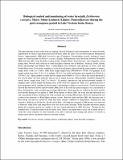| dc.description.abstract | The paper presents recent results from an ongoing classical biological control programme for water hyacinth,
implemented by Kenya Agricultural Research Institute under the Lake Victoria Environmental Management
Project. Approximately 5600 adult Neochetina spp. (Coleoptera: Curculionidae) weevils, biological control
agents for water hyacinth Eichhornia crassipes (Liliales: Ponteridaceae) were harvested, between November
2000 and June 2001, from the Kibos rearing facility, Namba-Okana "field insectary" and community weevil
rearing units. Weevils were released on water hyacinth at thirteen sites in Berkeley, Nyakach, Osodo, Kendu,
Homa and Karungu and Muhuru Bays, at Kuja-Migori river tributaries and upstream of Nzoia, Yala and
Sondu-Miriu rivers. Post-release sampling of water hyacinth plants indicated that the mean number of rametes
ranged from 1.4±0.2 to 3.3±0.4, while fresh weight ranged from 290.0±40.0 to 770.0± 73.0 grammes. Leaf
length ranged from short 21.4± 2.1 to medium, 50.7±1.5 cm while leaf laminar area ranged from 50.6±4.4 to
154.9±4.1 cm2. Mean number of adult weevils ranged from 0.0±0.0 to 5.5±1.4. Once the critical threshold of
five weevils plant-1 has been achieved, releases are no longer necessary. Mean number of petioles damaged by
weevil larvae, ranged from 2.9±2.7 to 8.6±5.4. In general, reproductive and growth potential (number of
daughter plants, petiole length and laminar area) of the weed was suppressed. There was a gradual increase in
insect population levels (number of weevils plant-1) and damage to plants by weevil larvae. Visual observations
showed that between October and November 2000, most of the water hyacinth resurgence was concentrated at
Kusa, Nyakach bay, with a resident mat covering 300 hectares. Fresh growth was evident in the Nzoia and Sio
river-mouths during the last quarter of 2000. From January to March 2001, the water hyacinth infestation was
still concentrated at Kusa, Nyakach bay with a resident mat covering 400 hectares. However, fresh growth was
evident in the tributaries of Kuja-Migori riverine system. Between April and June 2001, the stationary mat at
Kusa broke off and was moved by wind and water currents southwest to Sango-Rota, Nyakach bay and
onwards to Rakwaro in Osodo bay. By the end of May, a floating mat estimated at 400 hectares was observed
at Rakwaro while Kusa and Sango-Rota were free from water hyacinth. Water hyacinth infestation pattern
during the resurgence period was similar to the one at peak infestation in 1998. However, Kisumu bay has
remained free of water hyacinth for the last three years. There is an urgent need to carry out an aerial survey to
verify the visual estimates of water hyacinth cover and to intensify mass rearing and releases of weevils in
hotspot areas and to concentrate releases in riverine systems | en_US |

